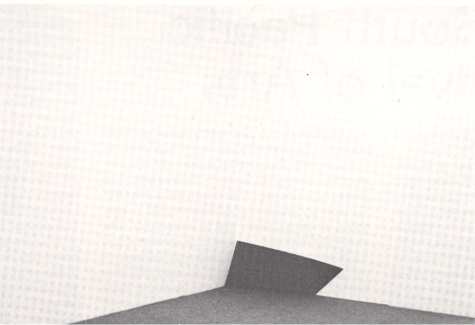John Bailey's Wall Drawings
WYSTAN CURNOW
In most exhibitions all the paintings, or sculptures, are the same - with variations. I can see why this should be, but it does get a bit boring. Neither of John Bailey's Auckland exhibitions have been like that. Both have given a progression, an impression of the oeuvre working itself out. You want to ask: how does he get from that one thereto this one here? In his last show you wanted to know how he got from a series of black and white grid patterns to some colourful images stepping out across the paper. Here you want to know how he gets from his drawings of a square tipped into a corner to the image that he has actually drawn in charcoal on a corner formed by the floor and two walls of the gallery. The more you look at the two items the less simple the transference seems; the less similar seem the images in the drawings and that on the surfaces of the gallery space.

A view of the installed
Wall Drawing, 1980 at the
Peter Webb Galleries
Again it's a stepping out we see. There's a parallel to be drawn with Rick Killeen. He is also an artist who insists on keeping his art on the move. Both have ostensibly made moves which permit them to do things painting once did but gave upon and to do them without retreating to old territory. Both have left the canvas behind them and replaced its frame with the literal frame of the gallery wall (in Killeen's case) and the gallery space (in Bailey's). Bailey has not, however, wanted to do what Killeen has done. His use of the givens of the gallery is quite different. He has moved off the flat - one important distinction between these drawings and those of his last show is .that these are exclusively involved in 'representing' three dimensions. And .they are about that as a problem.

JOHN BAILEY
Corner/wall/floor study 1980
Pastel on paper, 350 x 360 mm.
(Collection of Christine Tattersfield)
The image projected in the gallery installation
The drawings here that are on paper and framed are of a square flat plane in space that has got bent somewhat as a result of its placement in a corner. These drawings are also about that; about painting or drawing 'in a corner'. (Has art painted itself into one?) Although it is readily to be inferred that the image drawn in the actual corner of the gallery is that same tipped square plane of the drawings on paper, I found it impossible to decide how he'd done it. That is to say, the image had me walking around the space, squatting down, standing tip toe, trying to figure out just from which angle and from what height the artist had 'projected' it.
The other thing was that this image did what the drawings did; it gave the impression of an image which 'masked' or 'hid' the three dimensions of the corner. It made the corner dissolve into its intense charcoal greyness. In looking for that single angle of projection, I was looking to reinforce the fiction of that dissolution, that flattening of the corner, at the same time as I was, by my own movements, canvassing the real space of the gallery. There's a nice irony to that.

JOHN BAILEY
Wall Drawing: projected image 1980
Charcoal on wall/floor
(Peter Webb Galleries)
A combined photograph showing the image projected on both sides of the gallery dividing wall
The charcoaled image occupied a corner formed by the long wall of the gallery and a partition wall which partially divided the space into a larger and a smaller room. The image first met with is the one in the larger room. But another was to be found on the other side of the partition. The two images are identical, but back to back. This is, of course, a pretty interesting idea. To that of dissolving the corner may be added the idea of dissolving the partition. It is only tentatively stated, however; as if the artist came upon it rather late in the piece. Having moved into the given, he ought perhaps to have made a larger claim on it. Those two small images tucked away like that made too self-effacing a statement. I would have liked to see John Bailey stepping out with his baby in a livelier fashion. (He 'can't go wrong 'cos he's in right'.) Some bigger, some gutsy, figures would have pleased me more.